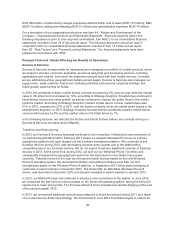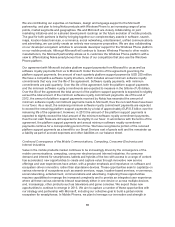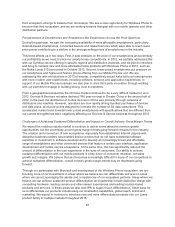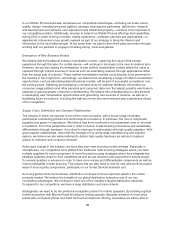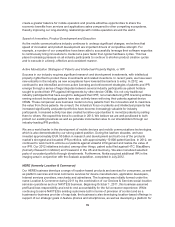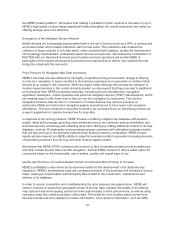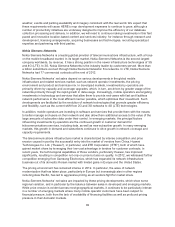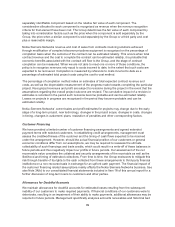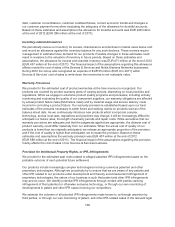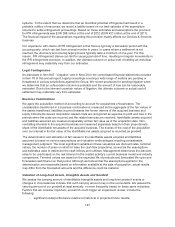Nokia 2012 Annual Report Download - page 94
Download and view the complete annual report
Please find page 94 of the 2012 Nokia annual report below. You can navigate through the pages in the report by either clicking on the pages listed below, or by using the keyword search tool below to find specific information within the annual report.Pricing pressure is evident in the traditional products markets, in particular, where competitors have
products with similar technological capabilities, leading to commoditization in some areas. Nokia Siemens
Networks’ ability to compete in those markets is determined by its ability to remain price competitive with
its industry peers. To remain competitive and differentiate Nokia Siemens Networks from its competitors,
it is therefore essential that Nokia Siemens Networks constantly improves its technology while
continuously reducing product costs to keep pace with price erosion. Nokia Siemens Networks has
continued to make progress in reducing product and procurement costs in 2012 and will need to focus on
this area in order to provide its customers with high-quality products at competitive prices.
Over recent years, the telecommunications infrastructure industry has entered a more mature phase
characterized by the completion of the greenfield roll-outs of mobile network infrastructure across many
markets, although this is further advanced in developed markets. Notwithstanding, there is still a
significant market for traditional network infrastructure products to meet coverage and capacity
requirements, even as older technologies such as 2G are supplanted by 3G and 4G (LTE). As growth
in traditional network products sales slows, there is an emphasis on the provision of network upgrades,
often through software, as well as applications, such as billing, charging and subscriber management
and services, particularly the outsourcing of non-core activities to companies that provide extensive
telecommunications expertise and strong managed service offerings.
In the following sections we describe the factors and trends that we believe are currently driving Nokia
Siemens Networks’ net sales and profitability.
Mobility and Data Usage
Over recent years the two most evident trends in the mobile and fixed network market—the rise in use
of mobile services and the exponential increase in data traffic—have converged. One result is that
services once regarded as available primarily, if not exclusively, through fixed or wireline networks are
increasingly in demand from mobile on wireless networks also.
Alongside traditional voice and data services, such as text messaging, end-users access a wealth of
media services through communications networks, including email and other business data,
entertainment services, including games and music, visual media, including high definition films and
television programming and social media sites. End-users increasingly expect that such services are
available to them everywhere, through both mobile and fixed networks, and a wealth of new devices,
optimized to allow them to do so, have become available including tablets, highly sophisticated
smartphones, mobile broadband data dongles, set-top boxes and mobile and fixed line telephones.
The widespread availability of devices has been matched by a proliferation of products and services in
the market that both meet and feed end-user demand. These continue to drive dramatic increases in
data traffic and signaling through both mobile access and transport networks that carry the potential to
cause network congestion and complexity. During 2012, this increase continued to gain momentum as
more users moved towards smartphones and tablets and even more devices that require constant
connectivity were introduced to the market.
While the growth in traffic is clear, it has not been met by corresponding growth in operators’ revenues
from data traffic, where growth appears to be slowing. This presents operators with a challenge: to
cope with the growing traffic load within networks, it is fundamental that operators continue to invest in
their networks, but within the financial constraints that their current business models dictate.
This means that while the addition of capacity, speed and coverage is crucial, it is critical that networks
are built efficiently and effectively in a manner that optimizes capital investment and delivers networks
with architecture sufficiently flexible to cope with evolving requirements.
93


